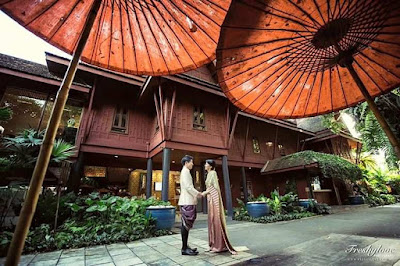It began as a remote bolthole for ex-pats and spies and became a Bangkok institution attracting Hollywood elite.
It was a simple enough invitation. Serial renegade ex-pat, motorcycle riding buddy, best-selling author, would-be pop star and all-around likable rogue,
Stu Lloyd, says “Join me for a quiet ale at
Check Inn 99. It’s open mic afternoon.”
Of course, I had no idea just what the scheming Rhodesian had in mind, but to say it turned into a rich and rewarding afternoon would be a gross understatement.
As I wandered into the little hole-in-the-wall establishment, the Sunday afternoon crowd was just warming up. A local Thai chap was ripping some serious blues chords on a big semi-acoustic Fender while sax and jazz keyboard players were taking their supporting roles very seriously. Stu wasn't kidding, some substantial talent already in the swing of things.
 |
| Band gets into the swing |
With red wine and tuna sandwiches laid on, Stu introduces me to Chris Catto-Smith, a former RAAF fighter jock who has run Check Inn 99 with his Thai wife, Jiraporn, known to her many friends as "Mook". Mook is the orphan of a slain senior Thai police officer and holds a high position within the force herself.
She’s not to be trifled with either. The Bangkok underworld plays a complicated game with a convoluted hierarchy that would take hours to explain. Suffice to say that when a posse of goons tried to shake down her newly reopened establishment, they left down-in-the-mouth, empty-handed and thoroughly chastened. Never to return.
I say ‘newly reopened’ because for nearly 60 years, Check Inn 99 occupied the same location on the now famous Sukhumvit strip between Sois 5 and 7, originally under the name ‘Copacabana’. Chris and Mook tidied up the place in 2011, turning the former go-go bar for US servicemen on R&R from Vietnam into a serious nightclub with good food, a well-stocked bar and quality live (musical) entertainment.
 |
| Sunday revellers settle in for 'just the one' L-R Stu Lloyd, guest, Chris Cato-Smith, Rod Eime. Stu is holding the Kevin Cummings book, Bangkok Beat, while I'm flashing Stu's soon-to-be-released 5th edition of Hardship Posting |
“The Copa was something of an institution back in the day,” Chris tells me over another red wine, “celebrities would hang out here and relax away from prying eyes. Bob Hope, Bing Crosby, Rachel Welch and David Bowie to name just a few. Not bad considering it started out with what were basically farm girls in ball gowns.”
 |
| 20-something Noi with Bob Hope in 1968 |
When a long-running struggle to save the original premises was lost, Chris and Mook took the name and the ghosts with them to a new spot in Soi 33 and did their best to revive the spirit. And the effort seems to have been largely successful.
 |
| A fresh-faced Noi in the 1960s |
One ghost that will never leave the Check Inn 99 is that of celebrity ‘mamasan’, known simply as Noi, or later Mama Noi. Noi passed away suddenly in 2016 after a career in the Bangkok nightlife scene that began as a feisty 17-year-old in 1960 at the ‘Copa’. Noi hailed from Ubon Ratchathani in the rural province of Isan to the northeast of Bangkok, a region that supplies much of the varied workforce in Bangkok.
Imbued with a classic Thai/Khmer beauty and oodles of spunk, the young Noi made rapid strides in the business and was largely responsible for the success of first The Copacabana and then Check Inn 99. The glitterati came to see her as much as hang out with their Hollywood cliques. She was frequently seen in close quarters with Bob Hope and his entourage and even ‘vacationed’ with them in the USA. She even briefly became something of a muse for the pop legend, David Bowie.
During the intermission, keyboard player, Keith, rocks up to our table and embraces Stu - as one does - like a long-lost pal. The three of us trade yarns from our time in the Australian music scene and discover much-overlapped history. It’s a small word.
Keith and William, the sax player, are whisked away for another jam session, joined by a mysterious and glamorous woman of colour. She belts out R&B, blues and gospel that fairly makes my spine tingle. The room is transfixed as her voice dominates. We’re in awe for a full 30 minutes.
As she leaves the stage to enthusiastic applause, she wanders nonchalantly to our table and chats effortlessly with the drinkers. I compliment her on a stellar performance and she smiles appreciatively before resuming the small talk. Stu elbows me in the ribs and whispers, “you know that’s Deni Hines!”
 |
| Miss Deni Hines with admirers |
Deni tells us she’s been in Bangkok for almost a year (who knew?) while still pursuing an active career in music as well as charity work.
Boy, she still has the goods and Check Inn 99’s reputation for impromptu A-Listers remains.
By now I should know what to expect when Stu asks me out for “just the one”.
- Roderick Eime
Check Inn 99 website:
http://checkinn99.com/
Sources and further reading:
Bangkok Beat by Kevin Cummings ISBN: 0692396454












